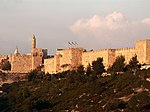Siege of Jerusalem (1244)
1240s in the Ayyubid Sultanate1244 in Asia1244 in Europe13th-century massacresBattles involving the Khwarazmian dynasty ... and 9 more
Conflicts in 1244Massacres of ChristiansMiddle Eastern history stubsMilitary history of the Crusader states between the Sixth and Seventh CrusadesRazed citiesSiege stubsSieges involving the Ayyubid SultanateSieges of JerusalemSieges of the Crusades

The 1244 siege of Jerusalem took place after the Sixth Crusade, when a Khwarazmian army conquered the city on July 15, 1244.
Excerpt from the Wikipedia article Siege of Jerusalem (1244) (License: CC BY-SA 3.0, Authors, Images).Siege of Jerusalem (1244)
Agripas, Jerusalem Nahlaot
Geographical coordinates (GPS) Address Nearby Places Show on map
Geographical coordinates (GPS)
| Latitude | Longitude |
|---|---|
| N 31.783333055556 ° | E 35.216666944444 ° |
Address
Agripas 8
9422904 Jerusalem, Nahlaot
Jerusalem District, Israel
Open on Google Maps









